written and photographed by Mary L. Peachin
Jun 1998, Vol. 2 No. 9
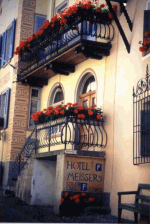 As summer turns to fall, the tinkling of brass bells echoes across the valleys of the Engadine, in the Swiss Alps. The sound of the traditional bells, hung from the necks of brown cows, will disappear from the local symphony as the cows are herded to the milder climate of the lower pastures. As winter draws near and the mountains gain a coat of snow, skiing replaces hiking and mountain bicycling as the primary attraction to this northeastern region of Switzerland.
As summer turns to fall, the tinkling of brass bells echoes across the valleys of the Engadine, in the Swiss Alps. The sound of the traditional bells, hung from the necks of brown cows, will disappear from the local symphony as the cows are herded to the milder climate of the lower pastures. As winter draws near and the mountains gain a coat of snow, skiing replaces hiking and mountain bicycling as the primary attraction to this northeastern region of Switzerland.
During the summer months and into the early fall, the Engadine region bustles with backpackers and hikers who travel from village to village by train, tram, and funicular (airborne cable car). Looking to avoid the crush of booked rooms and crowded trails, my husband David and I booked a mid-September tour with a tour company called Off the Beaten Path, which was leading this special tour in the Engadine region of the Alps.
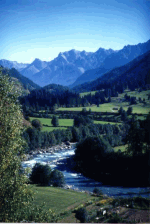 We flew Swiss Air from Los Angeles to Zurich, the gateway city of the Engadine region. We’d left ourselves a few days before the hiking tour began to explore the other attractions of northeastern Switzerland.
We flew Swiss Air from Los Angeles to Zurich, the gateway city of the Engadine region. We’d left ourselves a few days before the hiking tour began to explore the other attractions of northeastern Switzerland.
We spent the first night at Andre Jaeger’s charming Rheinhotel Fischerunt, in Schaffhausen. Located on the banks of the Rhine thirty miles north of Zurich, the inn is a great place to recover from jet lag. The quiet charm of the small village and its proximity to the bustling metropolis of Zurich all made for a pleasant stay. And the incredible cuisine offered in the attached restaurant, prepared by a Mr. Jaeger (one of Europe’s finest chefs and the proud recipient of a Michelin star), is an added bonus.
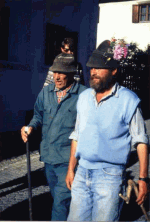 We then spent a few days enjoying Zurich, where our base of operations was Bar-Hotel Rossli, a small modern hotel conveniently located in old Zurich and within walking distance of most areas of the city. We enjoyed the cosmopolitan city with its cobblestone streets, haute couture, fine restaurants, and artistic offerings, but it was soon time for the more active portion of our trip.
We then spent a few days enjoying Zurich, where our base of operations was Bar-Hotel Rossli, a small modern hotel conveniently located in old Zurich and within walking distance of most areas of the city. We enjoyed the cosmopolitan city with its cobblestone streets, haute couture, fine restaurants, and artistic offerings, but it was soon time for the more active portion of our trip.
We began in the colorful hillside town of Guarda. Located about three hours from Zurich, the cobblestoned town is filled with medieval buildings painted with decorative graffiti. We checked into the Hotel Meisser, a converted farmhouse (circa 1645) whose rooms were paneled in local arven wood and featured views of the meandering Inn River.
The next morning, we began our first hike, a ten-mile trek along the historic trail to Scuol, a portion of the medieval-era road from Milan to Innsbruck. Hiking along a ridge trail, we had great views of the surrounding mountains and the valley below.
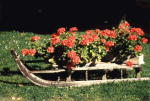 As we neared Scuol, we caught a glimpse of the Tarasp Castle near the village. Romanesque spires towered above the treeline. After a few hours in town, we returned to Guarda by train and postal bus, then walked the last mile uphill to the village. Over the next three days, small groups explored the countryside in all directions. Several of our group hiked the five miles to Lavin, five miles traversing a trail along the banks of the Inn River. Others made the challenging climb through the larch forest in Pra Davant, continuing on to the Alp Scuot and Furcletta. The trail was challenging, but once again the views of the alps were terrific.
As we neared Scuol, we caught a glimpse of the Tarasp Castle near the village. Romanesque spires towered above the treeline. After a few hours in town, we returned to Guarda by train and postal bus, then walked the last mile uphill to the village. Over the next three days, small groups explored the countryside in all directions. Several of our group hiked the five miles to Lavin, five miles traversing a trail along the banks of the Inn River. Others made the challenging climb through the larch forest in Pra Davant, continuing on to the Alp Scuot and Furcletta. The trail was challenging, but once again the views of the alps were terrific.
During our three days in Guarda, we had the good luck to see the town’s end-of-summer harvest celebration. Farmers led their cows (both species adorned with floral wreaths) through the village en route to their lower winter pastures, and the whole town turned out to watch.
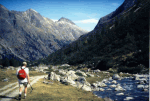 Our second base of operations was Celerina, a forty-five minute bus ride from Guarda and near the ski village of St. Moritz. Chesa Rosatch, our hotel, was more than 800 years old and had been recently renovated without losing its charm and history.
Our second base of operations was Celerina, a forty-five minute bus ride from Guarda and near the ski village of St. Moritz. Chesa Rosatch, our hotel, was more than 800 years old and had been recently renovated without losing its charm and history.
The first day in Celerina, we hiked 45 minutes to Punt Maragl, where we caught a funicular to Muotas Maragi. We hiked for two hours more, following the trail around Mt. Languard. This trail followed a narrow ridge around the midline of the mountains. Descending by ski lift to the town of Pontresina, we then caught a train back to Celerina.
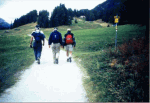 Another day, we took a train Celerina to Pontresina where we hiked four miles to the Roseg Inn. The trail followed a glacial stream through a valley inhabited by red stag and chamois goats. Several of our group then returned to Pontresina by horse and carriage. The rest of us continued our hike, enjoying a picnic in the shadow of the majestic Roseg Glacier.
Another day, we took a train Celerina to Pontresina where we hiked four miles to the Roseg Inn. The trail followed a glacial stream through a valley inhabited by red stag and chamois goats. Several of our group then returned to Pontresina by horse and carriage. The rest of us continued our hike, enjoying a picnic in the shadow of the majestic Roseg Glacier.
 The next morning we caught a bus to St. Moritz, the Corvatsch funicular to Corviglia, and finally a cable car to Piz Nair high in the Alps, at 10,027 feet overlooking a gray shale pass and, below that, a mass of colorful trees that marked the Suvretta Valley. After taking in the view, we descended past the treeline, into a bright flurry of autumn leaves. We walked below the trees, eventually following a small stream until it emerged behind the Spinas train station. We waited for the train to Celerina at a nearby inn, where we enjoyed a cold beer before heading back into town.
The next morning we caught a bus to St. Moritz, the Corvatsch funicular to Corviglia, and finally a cable car to Piz Nair high in the Alps, at 10,027 feet overlooking a gray shale pass and, below that, a mass of colorful trees that marked the Suvretta Valley. After taking in the view, we descended past the treeline, into a bright flurry of autumn leaves. We walked below the trees, eventually following a small stream until it emerged behind the Spinas train station. We waited for the train to Celerina at a nearby inn, where we enjoyed a cold beer before heading back into town.
Our final day was spent hiking around Lake Silvaplana, in the upper Engadine. The trail was a fairly level loop around the lake. The trail ended at Sils Maria, where we boarded a bus for St. Moritz. The afternoon was spent browsing through the glitzy shops of St. Moritz.
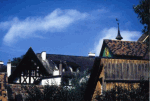 Switzerland is a country where even the public baths are squeaky clean. Everything operates precisely. Trains operate on schedule, food is good, the people are friendly, and yes, the prices are high. Switzerland has long been a destination for those wanting to ski the Swiss Alps. Hiking during the summer and fall months offers another opportunity to enjoy this scenic destination.
Switzerland is a country where even the public baths are squeaky clean. Everything operates precisely. Trains operate on schedule, food is good, the people are friendly, and yes, the prices are high. Switzerland has long been a destination for those wanting to ski the Swiss Alps. Hiking during the summer and fall months offers another opportunity to enjoy this scenic destination.
